高级数据结构
文章目录
二叉查找树
重复节点的插入应该如何处理?需要支持么?
1.重复的节点部分拉一条链出来,类似链表或者动态扩容数组
2.把这个新插入的数据当作大于这个节点的值来处理。
1、删除叶子节点
2、删除出度为1的节点
3、删除入读为2的节点
找到前驱或者后继替换后 转换为度为1的节点删除的问题
定义:
一个结点的后继,是大于x.key的最小关键字的结点。
一个结点的前驱,是小于x.key的最大关键字的结点。
完全二叉树、满二叉树,查找时间复杂度与树的高度成正比,O(h) —— O(logN)
与其他数据结构和算法相比,二叉查找树有什么优劣点?
都是查找,二叉查找树和hash相比有什么特点?
速度对比:
-
哈希表的插入、删除、查找的时间复杂度都是 O(1);
而平衡二叉查找树的插入、删除、查找的时间复杂度都是 O(logn)。 -
散列表扩容耗时很多,而且当遇到散列冲突时,性能不稳定,尽管二叉查找树的性能不稳定,但是在工程中,我们最常用的平衡二叉查找树的性能非常稳定,时间复杂度稳定在 O(logn)。
-
笼统地来说,尽管散列表的查找等操作的时间复杂度是常量级的,但因为哈希冲突的存在,这个常量不一定比 logn 小,所以实际的查找速度可能不一定比 O(logn) 快。加上哈希函数的耗时,也不一定就比平衡二叉查找树的效率高。
操作对比/功能对比:
- 散列表中的数据是无序存储的,如果要输出有序的数据,需要先进行排序。而对于二叉查找树来说,我们只需要中序遍历,就可以在 O(n) 的时间复杂度内,输出有序的数据序列。
- 散列表的构造比二叉查找树要复杂,需要考虑的东西很多。比如散列函数的设计、冲突解决办法、扩缩容等。平衡二叉查找树只需要考虑平衡性这一个问题,而且这个问题的解决方案比较成熟、固定。
二叉查找树 代码演示
#include <stdio.h>
#include <stdlib.h>
#include <time.h>
using namespace std;
typedef struct Node {
int value, size;
struct Node *left, *right;
} Node;
Node __NIL; //哨兵节点
#define NIL (&__NIL)
__attribute__((constructor))
void init_NTL() {
NIL->value = 0;
NIL->size = 0;
NIL->left = NIL->right = NIL;
}
Node *getNewNode(int key) {
Node *p = (Node *)malloc(sizeof(Node));
p->value = key;
p->size = 1;
p->left = p->right = NIL;
return p;
}
void update_size(Node *root) {
root->size = root->left->size + root->right + 1;
return ;
}
Node *insert(Node *root, int target) {
if (root == NIL) return getNewNode(target);
if (root->value == target) return root;
if (root->value > targeet) {
root->left = insert(root->left, target);
} else {
root->right = insert(root->right, target);
}
update_size(root);
//root->size = 0;
//if (root->left != NULL) root->size += root->left->size;
//if (root->right != NULL) root->size += root->right->size;
return root;
}
void clear(Node *root) {
if (root == NIL) return ;
clear(root->left);
clear(root->right);
free(root);
return ;
}
int search(Node *root, int target) {
if (root == NIL) return 0;
if (root->value == target) return 1;
if (root->value > target) {
return search(root->left, target);
}
return search(root->right, target);
}
Node *predecessor(Node *root) {
Node *p = root->left;
while (p != NIL && p->right != NIL) {
p = p->right;
}
return p;
}
Node *erase(Node *root, int target) {
if (root == NIL) return root;
if (root->value > target) {
root->left = erase(root->left, target);
} else if (root->value < target) {
root->right = erase(root->right, target);
} else {
//if (root->right == NULL && root->left == NULL) { // 冗余操作
// free(root);
// return NULL;
//} else
if(root->right == NIL || root->left == NIL) {
Node *tmp = root->left != NIL ? root->left : root->right;
free(root);
return tmp; // 返回不为空的节点
} else { // 与前驱节点交换
Node *tmp = predecessor(root); // 找到前驱节点
root->value = tmp->value; //删除当前根节点
root->left = erase(root->left, tmp->value); //删除原来根节点的前驱节点
}
}
update_size(root);
return root;
}
void in_order(Node *root) {
if (root == NIL) return ;
in_order(root->left);
printf("%d ", root->value);
in_order(root->right);
return ;
}
int find_k(Node *root, int k) { //求第k大的数
if (root->right->size >= k) { // 右边 第k大的数
return find_k(root->right, k);
}
if (root->right->size + 1 == k) {
return root->value;
}
return find_k(root->left, k - root->right->size - 1); // 左边第(k - 右边节点)大的数
}
int main() {
int n;
scanf("%d", &n);
for (int i = 0; i < n; i++) {
int num = rand() % 100;
printf("%d ", num);
root = insert(root, num);
}
printf("\n");
in_order(root);
while (scanf("%d", &n) != EOF) {
printf("delete node is %d\n", n);
root = erase(root, n);
in_order(root); printf("\n");
printf("delete is success\n");
}
return 0;
}
Leetcode 110 Leetcode 669 剑指offer 54 Leetcode 450
平衡二叉树
AVL树
性质:
l H(left) - H(right) l <=1 左右子树高度差一
优点:
由于对每个节点的左右子树的树高做了限制,所以整棵树不会退化成一个链表
1、高度为H的BS 树,所包含的节点数量在什么范围之内?
H<= SIZE(H) <= 2^H - 1
2、高度为H的AVL树,所包含的节点数量在什么范围之内?
low(H - 2) + low(H - 1) + 1 <= SIZE(H) <= 2^H - 1 左右子树的最小高度的数量 + 根节点 = 当前高度最小数量
low(1) - 1, low(2) = 2, low(3) = 4, low(4) = 7; …
AVL 树
- AVL 树 - 失衡条件
LL 左子树的左子树多了 LR左子树的右子树多了(先小左旋(LL型)-在大右旋转)
RR右子树的右子树多了 RL右子树的左子树多了(先小右旋(RR型)-在大左旋转) - 回溯的方式判断查看是否平衡
LL型

H1 = H2 + 1 K2 = K3 + 2(失衡) K2 = h1 + 1 K3 = max(h3, h4) + 1
H1 = h2 + 1 =max(h3, h4) + 2
LR型 先小左旋(LL型)-在大右旋转
K2 = K3 + 1 K3 = max(h2, h3) + 1 K3 = h1 + 1 K2 = h4 + 2(失衡)
K2 = h1 + 2 = max(h2, h3) + 2 = h4 + 2
h1 = max(h2, h3) =h4
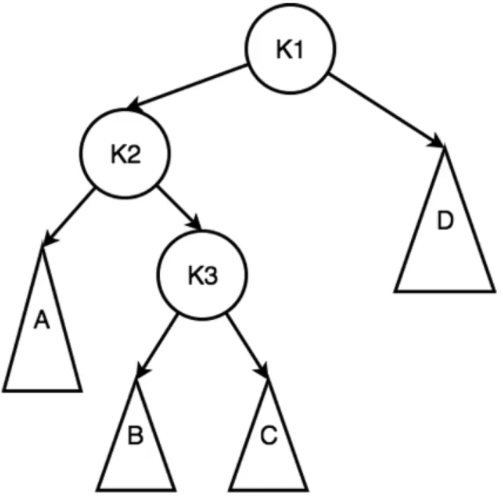
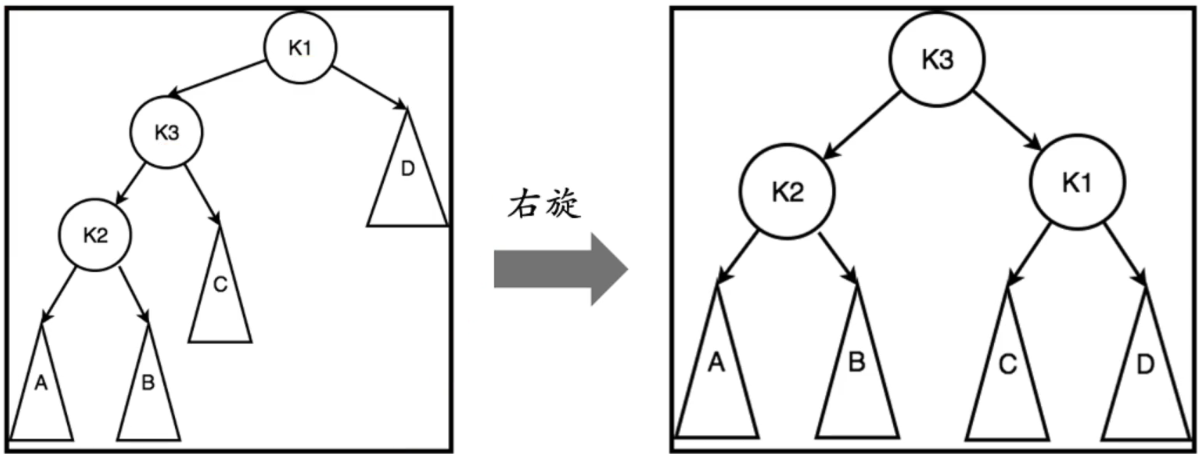
什么时候用AVL树
插入和删除操作较少,查找操作较多用AVL树,否则用BST树
AVL树是一种高度平衡的二叉树,所以查找的效率非常高,但是,有利就有弊,
AVL树为了维持这种高度的平衡,就要付出更多的代价。每次插入、删除都要做调整,
就比较复杂、耗时。所以,对于有频繁的插入、删除操作的数据集合,使用AVL树的代价就有点高了。
代码展示
左旋
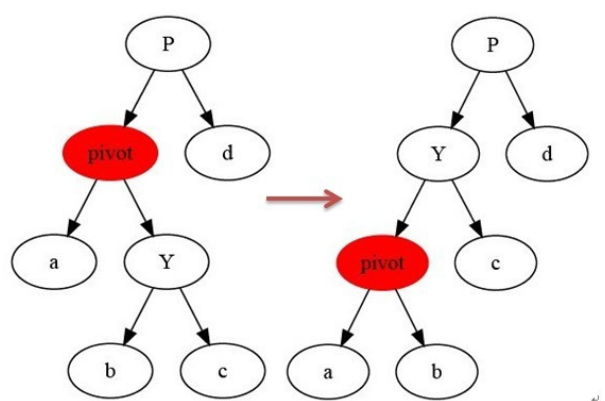
右旋
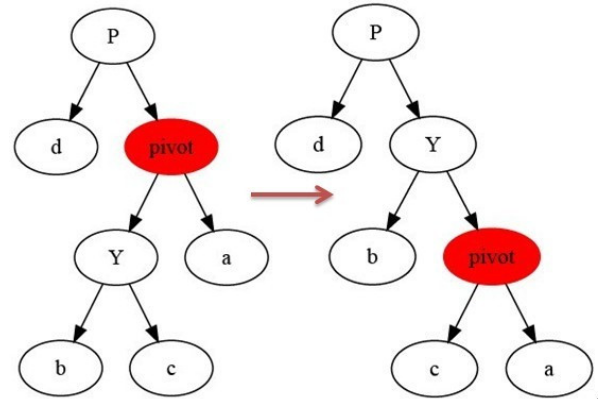
#include <cstdio>
#include <cstring>
#include <sstream>
#include <ctime>
#include <stdint.h>
#define max(a, b) ((a) > (b) ? (a) : (b))
typedef struct Node {
int value, h;
struct Node* left, * right;
} Node;
Node __NIL;
#define NIL (&__NIL)
//_attribute__((constructor)) //如果函数被设定为constructor属性,则该函数会在main()函数执行之前被自动的执行;
void init_NIL() {
NIL->value = -1;
NIL->h = 0;
NIL->left = NIL->right = NIL;
return;
}
Node* getNewNode(int target) {
Node* p = (Node*)malloc(sizeof(Node));
p->value = target;
p->left = p->right = NIL;
p->h = 1;
return p;
}
void clear(Node* root) {
if (root == NIL) return;
clear(root->right);
clear(root->left);
free(root);
return;
}
int search(Node* root, int target) {
if (root == NIL) return 0;
if (root->value == target) return 1;
if (root->value > target) {
return search(root->left, target);
}
return search(root->left, target);
}
void update_h(Node* root) {
root->h = max(root->left->h, root->right->h) + 1;
return;
}
Node* left_rotate(Node* root) {
printf("left rotate : %d\n", root->value);
Node* tmp = root->right;
root->right = tmp->left;
tmp->left = root;
update_h(root);
update_h(tmp);
return tmp;
}
Node* right_rotate(Node* root) {
printf("right rotate : %d\n", root->value);
Node* tmp = root->left;
root->left = tmp->right;
tmp->right = root;
update_h(root);
update_h(tmp);
return tmp;
}
const char* maintain_str[] = { "","LL", "LR", "RL", "RR" };
Node* maintain(Node* root) {
if (abs(root->left->h - root->right->h) <= 1) return root;
int maintain_type = 0;
if (root->left->h > root->right->h) { // 证明左子树更高,失衡条件是L
if (root->left->right->h > root->left->left->h) { // LR型
root->left = left_rotate(root->left); //左旋
maintain_type = 2; //LR
}
else {
maintain_type = 1; //LL
}
root = right_rotate(root); //右旋
}
else { // 右子树比左子树更好,失衡条件是R
if (root->right->left->h > root->right->right->h) { //RL型
root->left = right_rotate(root->right); //右旋
maintain_type = 3; //RL
}
else {
maintain_type = 4; //RR
}
root = left_rotate(root); //左旋
}
printf("AVL maintain_type = %s\n", maintain_str[maintain_type]);
return root;
}
Node* insert(Node* root, int target) {
if (root == NIL) return getNewNode(target);
if (root->value == target) return root;
if (root->value > target) {
root->left = insert(root->left, target);
}
else {
root->right = insert(root->right, target);
}
update_h(root);
return maintain(root);
}
Node* get_pre(Node* root) { // 前驱节点 前驱节点:当前节点左子树的最右节点,若无左子树,则:当前节点是其父节点的右子树
Node* tmp = root;
while (tmp->right != NIL) {
tmp = tmp->right;
}
return tmp;
}
Node* erase(Node* root, int target) {
if (root == NIL) return root;
if (root->value > target) {
root->left = erase(root->left, target);
}
else if (root->value < target) {
root->right = erase(root->right, target);
}
else {
if (root->left == NIL || root->right == NIL) {
Node* tmp = (root->left != NIL) ? root->left : root->right;
free(root);
return tmp;
}
else {
Node* tmp = get_pre(root->left);
root->value = tmp->value;
root->left = erase(root->left, tmp->value);
}
}
update_h(root);
return maintain(root);
}
void output(Node* root) {
if (root == NIL) return;
printf("(%d(%d) | %d , %d)\n", root->value, root->h, root->left->value, root->right->value);
output(root->left);
output(root->right);
}
int main() {
init_NIL();
srand(time(0));
Node* root = NIL;
int n;
scanf("%d", &n);
for (int i = 0; i < n; i++) {
int val = rand() % 100;
printf("\ninsert %d to tree: \n", val);
root = insert(root, val);
output(root);
}
clear(root);
return 0;
}

字典树
Trie 字典树 单词树 前缀树
作用:单词查找 字符串排序 字符串匹配功能
利用树形结构,对空间优化,把很多前缀一样的进行存储
代码展示(1)
#include <cstdio>
#include <cstring>
#include <sstream>
#include <ctime>
#define base 26
typedef struct Node {
int flag;
struct Node *next[base]; // [0] -> a, [1] -> b
} Node;
Node *getNewNode() {
Node *p = (Node *)malloc(sizeof(Node));
p->flag = 0;
memset(p->next, 0, sizeof(Node *) * base);
return p;
}
void clear(Node *root) {
if(root == NULL) return ;
for(int i = 0; i < base; i++) {
clear(root->next[i]);
}
free(root);
return ;
}
void insert(Node *root, const char *str) {
Node *p = root;
for(int i = 0; str[i]; i++) {
int ind = str[i] - 'a';
if(p->next[ind] == NULL) p->next[ind] = getNewNode();
p = p->next[ind]; }
p->flag = 1;
return ;
}
int find(Node *root, const char *str) {
Node *p = root;
for(int i = 0; str[i]; i++) {
int ind = str[i] - 'a';
p = p->next[ind];
if(p == NULL) return 0;
}
return p->flag;
}
void output(Node *root, int k, char *buff) {
if(root == NULL) return ;
buff[k] = '\0';
if(root->flag) {
printf("%s\n", buff);
}
for(int i = 0; i < base; i++) {
buff[k] = 'a' + i;
output(root->next[i], k + 1, buff);
}
return ;
}
int main() {
int op;
char str[100];
Node *root = getNewNode();
while(scanf("%d", &op) != EOF) {
switch (op) {
case 1: {
scanf("%s", str);
printf("insert %s to tire\n", str);
insert(root, str);
} break;
case 2: {
scanf("%s", str);
printf("find %s in tree = %d\n",str, find(root, str));
} break;
case 3: {
char buff[100];
output(root, 0, buff);
} break;
}
}
clear(root);
return 0;
}
Trie树的优缺点
优点︰查找高效,并且利用前缀来节约空间
缺点∶空间复杂度过高
1、空间上的不确定性
2、输入上的不确定性
无法利用CPU缓存,无法名字
思考∶如何解决空间复杂度过高的问题? 缩点
1、hash
2、平衡查找树
- 完全二叉树,实际存储结构是连续数组空间,思维逻辑结构是树型的
- 完全二叉树,节省了大量的存储边的空间
- 优化思想:记录式 改 计算式
- n n n 个节点的字典树,有效使用 n − 1 n-1 n−1 条边,浪费了 ( k − 1 ) ∗ n + 1 (k-1)*n+1 (k−1)∗n+1 条边的存储空间
- 参考完全二叉树的优点,提出了双数组字典树
oj.281
代码展示(2) 利用数组存储字典树
竞赛字典树实现方式
#include <cstdio>
#include <cstring>
#include <sstream>
#include <ctime>
const int maxn = 1e6 + 10;
const int base = 26;
struct Node {
int cnt;
int next[base]; // address -> index 数组:数的计算代替地址的存储
} tree[maxn]; // 字典树 最多有maxn个
// 0 -- root 第一层
int root = 0, node_cnt = 1;
char str[maxn];
int getNewNode() {
return node_cnt++;
}
void insert(const char *str) {
int p = root;
for(int i = 0; str[i]; i++) {
int ind = str[i] - 'a';
if(tree[p].next[ind] == 0) {
tree[p].next[ind] = getNewNode(); //对于没有下一层的字母-申请新的一层
}
p = tree[p].next[ind];
}
tree[p].cnt += 1;
return ;
}
int find(const char *str) {
int p = root;
int ans = 0;
for(int i = 0; str[i]; i++) {
int ind = str[i] - 'a';
p = tree[p].next[ind];
if(p == 0) return ans;
ans += tree[p].cnt;
}
return ans;
}
int main() {
int n, m;
scanf("%d%d", &n, &m);
for(int i = 0; i < n; i++) {
scanf("%s", str);
insert(str);
}
for(int i = 0; i < m; i++) {
scanf("%s", str);
printf("%d\n", find(str));
}
return 0;
}
oj.282
#include <cstdio>
#include <cstring>
#include <sstream>
#include <ctime>
const int maxn = 3200000 + 10; //32 * 1e5 1e5个数字,每个数字最多申请32个不同的层
const int max_k = 30; //31位为符号位 0~30位为值
struct node {
int flag;
int next[2];
} tree[maxn];
int root = 0, node_cnt = 1;
int getnewnode() {
return node_cnt++;
}
void insert(int x) {
int p = root;
for(int i = max_k; i >= 0; i--) { //二进制的形式遍历 从大到小存储
int ind = !!(x & (1 << i));// 拿到x的第i位
/*
两个感叹号由此推导可以知道:
!!(非零)=1
!!(零)=0
*/
if(tree[p].next[ind] == 0) {
tree[p].next[ind] = getnewnode();
}
p = tree[p].next[ind];
}
tree[p].flag = 1;
return ;
}
int find(int x) {
int p = root;
int ans = 0;
for(int i = max_k; i >= 0; i--) { //二进制的形式遍历 从大到小查找
int ind = !(x & (1 << i));
if(tree[p].next[ind]) {
ans |= (1 << i); //异或 相加
p = tree[p].next[ind];
} else {
p = tree[p].next[!ind];
}
}
return ans;
}
int main() {
int n, ans = 0;
scanf("%d", &n);
for(int i = 0, val, fval = 0; i < n; i++) {
scanf("%d", &val);
if(i) fval = find(val);
ans = fval > ans ? fval : ans;
insert(val);
}
printf("%d\n", ans);
return 0;
}
int ind = !!(x & (1 << i));// 拿到x的第i位
两个感叹号由此推导可以知道:
!!(非零)=1
!!(零)=0
!!—— 归一化
双数组字典树
- 顾名思义,两个数组代表一棵字典树结构
- base 数组信息与子节点编号相关,base + i 就是第 i 个子节点编号
- check 数组信息负责做【亲子鉴定】,check 数组中用正负表示是否独立成词
- 不擅长进行动态插入操作
- 一次建立,终身使用
- 为了方便,基于普通字典树实现的双数组字典树
DATrie 离线构建,在线查询
base[s] + c = t
check[t] = s
check 负号 表示独立成词
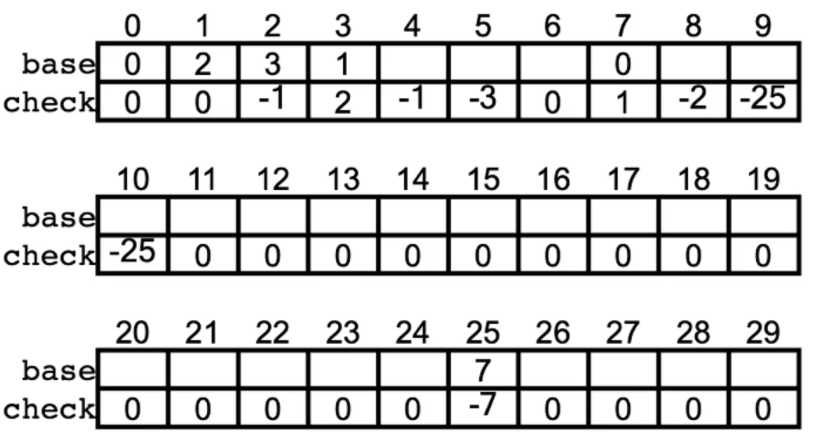
1为根节点
最长回文子串
马拉车算法 —— 充分利用对称性
d[k] 以k为中心最长的回文长度
d[i] = min(r - i, d[j] ) 如果d[j]长度超过r-i,并且此时d[i] = d[j]则说明 超过r的部分关于k也是对称的,r是错误的,r应该更长,所以不成立。
所以当d[j] < r- i 时,d[i] < d[j],否则 d[i] = r-i ; 少暴力一段
class Solution {
public:
string getNewString(string s) {
string ns = "#";
for(int i = 0; s[i]; i++) { //abcd #a#b#c#d# 减少判断方式 奇数:中心对称 偶数:两边对称
(ns += s[i]) += "#";
}
return ns;
}
string longestPalindrome(string s) {
if(s.size() == 0) return "";
string ns = getNewString(s);
vector<int> dis(ns.size());
int l = 0, r = -1;
for(int i = 0; i < ns.size(); i++) {
if(i > r) { dis[i] = 1;}
else { dis[i] = min(dis[l + r - i], r - i);}
while(i - dis[i] >= 0 && i + dis[i] < ns.size()
&& ns[i - dis[i]] == ns[i + dis[i]]) { //暴力匹配
dis[i]++; //半径
}
if(i + dis[i] > r && i - dis[i] > 0) {
l = i - dis[i];
r = i + dis[i];
}
}
string ret;
int tmp = 0;
for(int i = 0; ns[i]; i++) {
if(tmp >= dis[i]) continue;
tmp = dis[i];
ret = "";
for(int j = i - dis[i] + 1; j < i + dis[i]; j++) {
if(ns[j] == '#') continue;
ret += ns[j];
}
}
return ret;
}
};
并查集
#include <stdio.h>
#include <string.h>
#define maxn 1000010
int p[maxn];
int find(int x) {
if (p[x] != x) {
return p[x] = find(p[x]);
}
return p[x];
}
void merge(int x, int y) {
int fx = find(x);
int fy = find(y);
if (fx != fy) {
p[fx] = fy;
}
return ;
}
int main() {
int n, m, a, b;
scanf("%d%d", &n, &m);
for (int i = 0; i < m; i++) {
p[i] = i;
}
for (int i = 0; i < m; i++) {
scanf("%d%d", &a, &b);
}
int ans = 0;
for (int i = 0; i < n; i++) {
ans += (p[i] == i);
}
return 0;
}
冗余连接 II
返回一条能删除的边,使得剩下的图是有 n 个节点的有根树。若有多个答案,返回最后出现在给定二维数组的答案。
满足下列条件的有向图被称为有向树:
(1) 有且仅有一个结点的入度为0;
(2) 除树根外的结点入度为1;
(3) 从树根到任一结点有一条有向通路。
无环 ,入度<=1
class Solution {
public:
/*
思路 : 逐个删除边, 判断剩下的图, 是不是一个有向树
判断思路 :
1. 有且只有一个节点入度为0
2. 删除边后,除树根外的结点入度为1 (无环 且<2)
*/
int p[5000], flag1 = 0, flag2 = 0;
int find(int x) {
if(p[x] != x) return p[x] = find(p[x]);
return p[x];
}
void union_find(int x, int y) {
int fx = find(x);
int fy = find(y);
if(fx != fy) {
p[fx] = fy;
} else {
flag1 = 1; // 要进行连接的两个集合,之前不能已经连接了,否则就成环了
}
}
vector<int> findRedundantDirectedConnection(vector<vector<int>>& edges) {
int vis[5000] = {0};
for(int i = edges.size() - 1; i >= 0; i--) { // 逐个删除边
flag1 = 0, flag2 = 0;
int x = edges[i][0];
int y = edges[i][1];
memset(vis, 0, sizeof(vis));
for(int k = 0; k < 5000; k++) {
p[k] = k;
vis[k] = 0; // 入度为数组, 初始化为0
}
for(int j = 0; j < edges.size(); j++) {
if(edges[j][0] == x && edges[j][1] == y) { // 删除的那条边
continue;
}
union_find(edges[j][0], edges[j][1]); // 并查集 加入
if(flag1 == 1) break;
// 入度+1
vis[edges[j][1]]++;
if(vis[edges[j][1]] > 1) {
flag2 = 1;
break;
}
}
if(flag1 == 0 && flag2 == 0) {
return {x, y};
}
}
return edges[0]; // 随便一个返回值, 要不编译不过
}
};
最小生成树
kurskal(基于并查集)
1、sort 边 从小到大
2、遍历边 (并查集,判断有无环)
3、边两边的点加入T
给邻接图求最小生成树的长度
#include <iostream>
#include <algorithm>
#include <vector>
using namespace std;
const int maxn = 1e4 + 10;
int p[maxn];
struct edge {
int v, u, c;
};
bool cmp(edge x, edge y) {
return x.c < y.c;
}
vector<edge> e;
int find(int x) {
if(p[x] != x) return p[x] = find(p[x]);
return p[x];
}
int union_find(int x, int y) {
int fx = find(x);
int fy = find(y);
if(fx != fy) {
p[fx] = fy;
return 1; // 无环
}
return 0; //有环
}
int main() {
int n, x;
scanf("%d", &n);
for(int i = 0; i <= n; i++) {
p[i] = i;
}
for(int i = 1; i <= n; i++) {
for(int j = 1; j <= n; j++) {
scanf("%d", &x);
if(i == j) continue;
e.push_back({i, j, x});
}
}
sort(e.begin(), e.end(), cmp);
int ans = 0;
for(int i = 0; i < e.size(); i++) {
int v = e[i].v, u = e[i].u, c = e[i].c;
if(union_find(v, u)) {
ans += c;
}
}
printf("%d\n", ans);
return 0;
}
prim解法 选离集合最近的点 更适合邻接矩阵
#include <iostream>
#include <algorithm>
#include <cstdio>
#include <cstring>
#include <string>
#include <sstream>
#include <map>
#include <vector>
#include <set>
#include <unordered_map>
#include <time.h>
#include <stdint.h>
#include <queue>
#include <unordered_set>
#include <stack>
using namespace std;
const int maxn = 500 + 10;
const int inf = 0x3f3f3f3f;
int n, x;
int mp[maxn][maxn]; // 邻接矩阵
int vis[maxn], dis[maxn]; // vis 哪些点在G集合, 哪些在T集合, dis G中与T可达的点距离
void prim() {
vis[1] = 1; // 1节点加入到我们的T集合中去
for(int i = 1; i <= n; i++) {
dis[i] = mp[1][i]; // G集合中的点到T集合中的距离
}
for(int i = 2; i <= n; i++) { // 遍历所有的点
int minn = inf, v = -1; // v是我们找到的点
for(int j = 1; j <= n; j++) {
if(!vis[j] && minn > dis[j]) {
minn = dis[j];
v = j;
}
}
vis[v] = 1;
// 遍历所有非T集合中的点, 更新这些点到集合中的距离
for(int j = 1; j <= n; j++) {
if(!vis[j] && dis[j] > mp[v][j]) {
dis[j] = mp[v][j];
}
}
}
int sum = 0;
for(int i = 1; i <= n; i++) {
sum += dis[i];
}
printf("%d\n", sum);
return ;
}
int main() {
scanf("%d", &n);
for(int i = 1; i <= n; i++) {
for(int j = 1; j <= n; j++) {
scanf("%d", &x);
mp[i][j] = x;
}
}
prim();
return 0;
}
字符串匹配算法
朴素匹配算法Brute-Force
时间复杂度O(N*M)
#include <stdio.h>
#include <string.h>
int brute_force(const char *s, const char *t) {
for (int i = 0; s[i]; i++) {
int flag = 0;
for (int j = 0; t[j]; j++) {
if (s[i + j] == t[j]) continue;
flag = 1;
break;
}
if (flag == 0) return i;
}
return -1;
}
int main() {
char s[100], t[100];
scanf("%s%s", s, t);
printf("%d\n", brute_force(s, t));
return 0;
}
hash Rabin-Karp匹配法
对母串的每一个字串进行hash n-m+1次hash hash(A) = hash(B) A=B
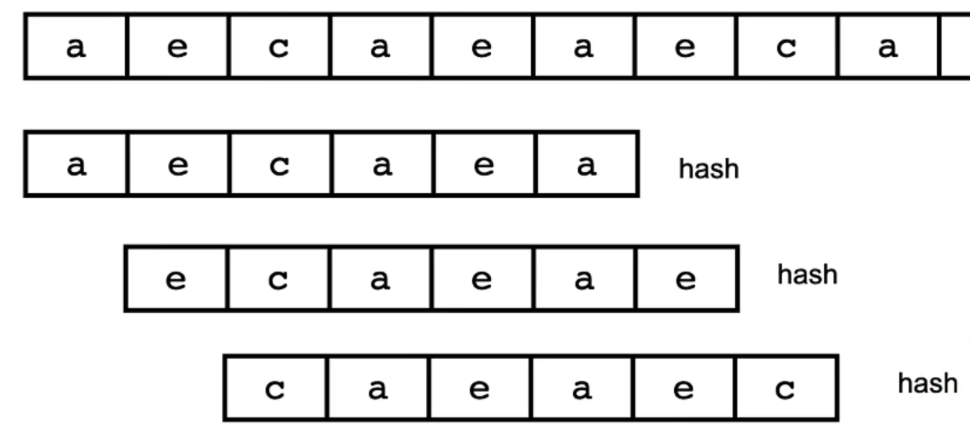
hash 的方法 abc = a * 26 * 26 + b * 26 + c
前一个:aeca hash(A) 后一个:ecae hash(B) hash(B) = hash(A) - (a * 26 * 26 * 26) + e
推导公式 h[i] = (h[i - 1] - 26 ^ (m - 1) * s[i - 1]) * 26 + s[i + m - 1]
问题:
1、hash值超过了int范围?
优化hash函数, 把字符与素数做映射, 而不是简单的a->1, b->2
优化hash函数, 更改hash策略, 直接把对应位置想加, 不做乘法法
2、hash冲突? 发送冲突,则直接对比 (子字符串)
时间复杂度:
最好:O(N)
最坏:O(N*M) (发送哈希冲突次数过多)
KMP算法
母串S
模式串T
一、关键点:求模式串 的每一个前缀的子前缀的相等的最长前缀和后缀
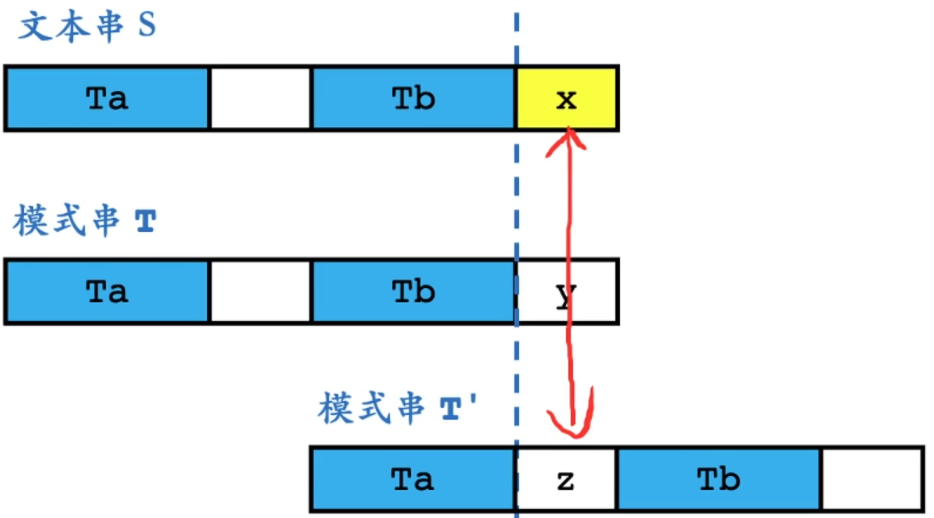
x!=y: 对比x和z
abcdab
| 子前缀 | 其相等的最长前缀和后缀 |
|---|---|
| a | a |
| ab | 无 |
| abc | 无 |
| abcd | 无 |
| abcda | a |
| abcdab | ab |
二、最长前缀后缀预处理

i = j 扩大 Sa 和 Sb,
i != j 利用sa和sb的最长前缀和后缀,再对比 i 和 j
如:模式串T abcxabcab
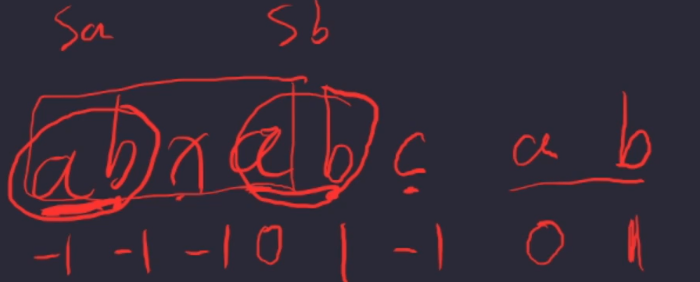
#include <stdio.h>
#include <string.h>
int next[100];
int kmp(const char *s, const char *t) { //s为母串, t为子串
//init next
next[0] = -1; //第一个字符的前后缀无意义
for(int i = 0, j = -1; t[i]; i++) { //最长前缀后缀预处理
while(j != -1 && t[j + 1] != t[i]) { //j!= -1 跳过第一个 t[j + 1] != t[i]第二种情况
j = next[j]; //利用sa和sb的最长前缀和后缀,再对比 i 和 j + 1
}
if (t[j + 1] == t[i]) { // t[j + 1] == t[i] 扩大 Sa 和 Sb
j++;
}
next[i] = j; //存 当前最长值
}
/*
for (int i = 0; i < 20; i++) { //next[i] 默认-1,加一即为真实值
printf("%d ", next[i]);
}
printf("\n");
*/
//match string
for(int i = 0, j = -1; s[i]; i++) {
while(j != -1 && s[i] != t[j + 1]) {
j = next[j];
}
if (s[i] == t[j + 1]) j++;
if (t[j + 1] == '\0') return i - j; //返回位置
}
return -1;
}
int main() {
char s[100], t[100];
scanf("%s%s", s, t);
kmp(s, t);
printf("%d\n", kmp(s, t));
return 0;
}
无注释版
int next[100];
int kmp(const char *s, const char *t) {
// init next
next[0] = -1;
for(int i = 1, j = -1; t[i]; i++) {
while(j != -1 && t[j + 1] != t[i]) { j = next[j]; }
if(t[j + 1] == t[i]) { j++; }
next[i] = j;
}
// match string
for(int i = 0, j = -1; s[i]; i++) {
while(j != -1 && s[i] != t[j + 1]) { j = next[j]; }
if(s[i] == t[j + 1]) j++;
if(t[j + 1] == '\0') return i - j;
}
return -1;
}
kmp 流式算法
a.out < input 512MB的内存处理10GB
hash算法
BM算法
Sunday算法
Sunday算法
- SUNDAY 算法理解的核心,在于理解对齐点位
- 是文本串的匹配尾部,一定会出现在模式串中的字符
- 文本串应该和模式串中最后一位(从后往前找的第一位)出现该字符的位置对齐
- 第一步:预处理**每一个字符(所有)**在模式串中最后一次出现的位置
- 第二步:模拟暴力匹配算法过程,失配的时候,文本串指针根据预处理信息向后移动若干位
int sunday(const char *s, const char *t) {
int len_s = strlen(s), len_t = strlen(t);
int ind[256];
//第一步:预处理每一个字符(所有 256个字符)在模式串中最后一次出现的位置
for (int i = 0; i < 256; i++) ind[i] = len_t + 1;
for (int i = 0; t[i]; i++) {
ind[t[i]] = len _t - i;
}
int i = 0;
while (i + len_t <= len_s) {
int flag = 1;
for (int j = 0; t[j]; j++) {
if (s[i + j] == t[j]) continue;
flag = 0;
break;
}
if (flag == 1) return i; // 找到了匹配, 直接返回位置
i += ind[s[i + len_t]]; // 匹配不成功, 找对齐点位, 出现在第几位, 就往后移动多少位置
}
return -1;
}
SHIFT-AND算法
模式串T转换为二维数组

d[a] = int(001001) 反过来

P = (P << 1 | 1) & d[s[i]]
P & (1 << (n - 1))
SHIFT-AND算法
-
第一步对模式串做特殊处理,把每一种字符出现的位置,转换成相应的二进制编码
-
后续匹配的过程中跟模式串一毛钱关系都没有
-
P的结构定义:
相应的位置为1,意味着当前文本串后缀能匹配到模式串的第几位前缀 -
P的结构操作:
文本串进来一个,对于每个p为1的地方,都有可能移动1位(都有可能多匹配一个字符),并且第一位O也有可能变成1,我们先假设,所有的1都能匹配得到假设完之后,开始验证我们的假设
时间复杂度 O(n+m)
#include <stdio.h>
#include <string.h>
int shift_and(const char *s, const char *t) {
int code[256] = {0};
int n = 0;
for(int i = 0; t[i]; i++, n++) {
code[t[i]] |= (1 << i); //t[i] 位置 加上 第i位的1
}
int p = 0;
for(int i = 0; s[i]; i++) {
p = (p << 1 | 1) & code[s[i]];
if(p & (1 << (n - 1))) return i - n + 1; // 和t的n个前缀相等则完成字符串匹配
}
return -1;
}
int main() {
char s[100], t[100];
scanf("%s%s", s, t);
printf("%d\n", shift_and(s, t));
return 0;
}
练习题:
给出一个正则表达式,形如:
(alb|c) &(c /d)&e& (f|a|b)
再给出一段文本,问文本中有多少段不同的子文本可以被上述
正则表达式匹配。
AC 自动机
kmp的基础上做的多模式匹配
多模匹配问题
- 有多个模式串的匹配问题,就是多模匹配问题
- Step1:多个模式串,建立成一棵字典树
- Step2:和文本串的每一位对齐匹配,模拟暴力匹配算法的过程
AC 自动机的思想
- 当匹配成功文本串中的 she 时,也就意味着后续一定会匹配成功 he
- she 对应了字典树中的节点 P,he 对应了字典树中的节点Q
- P 和 Q 就是等价匹配节点,如果从 P 引出一条边指向 Q,就可以加速匹配过程
- 在 P 下面查找节点的操作,等价于在 Q 下面查找节点的操作
- 这条等价关系边,通常在 AC 自动机上叫做 【Fail 指针】
- AC 自动机 = Trie + Fail 指针
- 子节点的 Fail 指针是需要参照父节点的 Fail指针信息的,最简单的建立方式,就是采用【层序遍历】
- 没做优化的 AC 自动机,本质上是一个 NFA(非确定型有穷状态自动机)
- 通俗理解:根据当前状态 p,以及输入字符 c,无法通过一步操作确定状态
- 第二种理解:当前状态,并不代表唯一状态。
#include <cstdio>
#include <cstring>
#include <sstream>
#include <ctime>
#define base 26
typedef struct Node {
const char *str;
struct Node *next[base], *fail;
} Node;
typedef struct Queue {
Node **data;
int head, tail;
} Queue;
Queue *initQueue(int n) {
Queue *q = (Queue *)malloc(sizeof(Queue));
q->data = (Node **)malloc(sizeof(Node *) * n);
q->head = q->tail = 0;
return q;
}
int empty(Queue *q) {
return q->tail - q->head == 0;
}
Node *front(Queue *q) {
return q->data[q->head];
}
void push(Queue *q, Node *node) {
q->data[q->tail++] = node;
}
void pop(Queue *q) {
if(empty(q)) return ;
q->head++;
return ;
}
void clearQueue(Queue *q) {
if(q == NULL) return ;
free(q->data);
free(q);
return ;
}
int node_cnt = 0;
Node *getNewNode() {
Node *p = (Node*)malloc(sizeof(Node));
p->str = NULL;
p->fail = NULL;
node_cnt++;
memset(p->next, 0, sizeof(Node *) * base);
return p;
}
void clear(Node *root) {
if(root == NULL) return ;
for(int i = 0; i < base; i++) {
clear(root->next[i]);
}
if(root->str) free((char *)root->str);
free(root);
return ;
}
const char *copyStr(const char *s) {
int n = strlen(s);
char *buff = (char *)malloc(n + 1);
strcpy(buff, s);
return buff;
}
void insert(Node *root, const char *s) {
Node *p = root;
for(int i = 0; s[i]; i++) {
if(p->next[s[i] - 'a'] == NULL) {
p->next[s[i] - 'a'] = getNewNode();
}
p = p->next[s[i] - 'a'];
}
p->str = copyStr(s);
return ;
}
void initBuildFaildQueue(Node *root, Queue *q) { //队列 root->next[i]先进先出
root->fail = NULL;
for(int i = 0; i < base; i++) {
if(root->next[i] == NULL) continue;
root->next[i]->fail = root;
push(q, root->next[i]);
}
return ;
}
void build_fail(Node *root) {
Queue *q = initQueue(node_cnt);
initBuildFaildQueue(root, q);
while(!empty(q)) {
Node *p = front(q);
for(int i = 0; i < base; i++) {
if(p->next[i] == NULL) continue;
Node *k = p->fail;
while(k != root && k->next[i] == NULL) {
k = k->fail;
}
if(k->next[i] != NULL) k = k->next[i];
p->next[i]->fail = k;
push(q, p->next[i]);
}
pop(q);
}
clearQueue(q);
return ;
}
void match_ac(Node *root, const char *s) {
Node *p = root, *q;
for(int i = 0; s[i]; i++) {
while(p != root && p->next[s[i] - 'a'] == NULL) {
p = p->fail;
}
if(p->next[s[i] - 'a']) p = p->next[s[i] - 'a'];
q = p;
while(q) {
if(q->str != NULL) printf("find %s\n", q->str);
q = q->fail;
}
}
return ;
}
int main() {
int n;
char s[100];
Node *root = getNewNode();
scanf("%d", &n);
for(int i = 0; i < n; i++) {
scanf("%s", s);
insert(root, s);
}
build_fail(root);
scanf("%s", s);
match_ac(root, s);
return 0;
}
经验O(N)
AC自动机的优化(有点类似并查集的路径压缩)
#include <cstdio>
#include <cstring>
#include <sstream>
#include <ctime>
#define base 26
typedef struct Node {
const char *str;
struct Node *next[base], *fail;
} Node;
typedef struct Queue {
Node **data;
int head, tail;
} Queue;
Queue *initQueue(int n) {
Queue *q = (Queue *)malloc(sizeof(Queue));
q->data = (Node **)malloc(sizeof(Node *) * n);
q->head = q->tail = 0;
return q;
}
int empty(Queue *q) {
return q->tail - q->head == 0;
}
Node *front(Queue *q) {
return q->data[q->head];
}
void push(Queue *q, Node *node) {
q->data[q->tail++] = node;
}
void pop(Queue *q) {
if(empty(q)) return ;
q->head++;
return ;
}
void clearQueue(Queue *q) {
if(q == NULL) return ;
free(q->data);
free(q);
return ;
}
int node_cnt = 0;
Node *getNewNode() {
Node *p = (Node*)malloc(sizeof(Node));
p->str = NULL;
p->fail = NULL;
node_cnt++;
memset(p->next, 0, sizeof(Node *) * base);
return p;
}
void clear(Node *root) {
if(root == NULL) return ;
for(int i = 0; i < base; i++) {
clear(root->next[i]);
}
if(root->str) free((char *)root->str);
free(root);
return ;
}
const char *copyStr(const char *s) {
int n = strlen(s);
char *buff = (char *)malloc(n + 1);
strcpy(buff, s);
return buff;
}
void insert(Node *root, const char *s) {
Node *p = root;
for(int i = 0; s[i]; i++) {
if(p->next[s[i] - 'a'] == NULL) {
p->next[s[i] - 'a'] = getNewNode();
}
p = p->next[s[i] - 'a'];
}
p->str = copyStr(s);
return ;
}
void initBuildFaildQueue(Node *root, Queue *q) {
root->fail = NULL;
for(int i = 0; i < base; i++) {
if(root->next[i] == NULL) {
root->next[i] = root;
continue;
}
root->next[i]->fail = root;
push(q, root->next[i]);
}
return ;
}
void build_fail(Node *root) {
Queue *q = initQueue(node_cnt);
initBuildFaildQueue(root, q);
while(!empty(q)) {
Node *p = front(q);
for(int i = 0; i < base; i++) {
if(p->next[i] == NULL) {
p->next[i] = p->fail->next[i];
continue;
}
Node *k = p->fail->next[i];
p->next[i]->fail = k;
push(q, p->next[i]);
}
pop(q);
}
clearQueue(q);
return ;
}
void match_ac(Node *root, const char *s) {
Node *p = root, *q;
for(int i = 0; s[i]; i++) {
p = p->next[s[i] - 'a'];
q = p;
while(q) {
if(q->str != NULL) printf("find %s\n", q->str);
q = q->fail;
}
}
return ;
}
int main() {
int n;
char s[100];
Node *root = getNewNode();
scanf("%d", &n);
for(int i = 0; i < n; i++) {
scanf("%s", s);
insert(root, s);
}
build_fail(root);
scanf("%s", s);
match_ac(root, s);
return 0;
}
字符串统计题
蒜头君某一天学习了 nn 个单词,他想看篇文章来复习下今天学习的内容,现在他想知道每个单词在这篇文章里分别出现了多少次,聪明的你能帮他解决这个问题吗?
输入格式
第一行输入一个整数 nn(1 \leq n \leq 10001≤n≤1000),表示蒜头君学习的 nn 个单词。
接下来 nn 行,每行输入一个字符串,仅由小写字母组成,长度不超过 2020。
最后输入一个字符串 SS,仅由小写字母组成,长度不超过 10^5105,表示蒜头君看的文章。
输出格式
依次输出 nn 行,每行输出格式为i: num,ii 表示单词的编号(从 00 开始编号),numnum 为一个整数,表示第 ii 个单词在母串 SS 中出现了 numnum 次。
样例输入复制
2
ab
bca
abcabc
样例输出复制
0: 2
1: 1
#include <stdio.h>
#include <stdlib.h>
#define base 26
const int maxn = 1e5 + 10;
struct Node {
int flag, *cnt;
int next[base], fail;
} tree[maxn];
int *ans[maxn];
int que[maxn], head, tail;
int root = 1, cnt = 2;
char s[maxn + 10];
int n;
int getNewNode() {
return cnt++;
}
int *insert(const char *s) {
int p = root;
for(int i = 0; s[i]; i++) {
int ind = s[i] - 'a';
if(tree[p].next[ind] == 0) tree[p].next[ind] = getNewNode();
p = tree[p].next[ind];
}
tree[p].flag = 1;
if(tree[p].cnt == NULL) {
tree[p].cnt = (int *)malloc(sizeof(int));
tree[p].cnt[0] = 0;
}
return tree[p].cnt;
}
void build_ac() {
head = tail = 0;
tree[root].fail = 0;
for(int i = 0; i < base; i++) {
if(tree[root].next[i] == 0) {
tree[root].next[i] = root;
continue;
}
tree[tree[root].next[i]].fail = root;
que[tail++] = tree[root].next[i];
}
while(head < tail) {
int p = que[head++];
for(int i = 0; i < base; i++) {
int c = tree[p].next[i], k = tree[p].fail;
if(c == 0) {
tree[p].next[i] = tree[k].next[i];
continue;
}
k = tree[k].next[i];
tree[c].fail = k;
que[tail++] = c;
}
}
return ;
}
void match_ac(const char *s) {
int p = root;
for(int i = 0; s[i]; i++) {
int ind = s[i] - 'a';
p = tree[p].next[ind];
int q = p;
while(q) {
if(tree[q].flag) {
tree[q].cnt[0]++;
}
q = tree[q].fail;
}
}
return ;
}
int main() {
scanf("%d", &n);
for(int i = 0; i < n; i++) {
scanf("%s", s);
ans[i] = insert(s);
}
build_ac();
scanf("%s", s);
match_ac(s);
for(int i = 0; i < n; i++) {
printf("%d: %d\n", i, *ans[i]);
}
return 0;
}
逆波兰式
#include <stdio.h>
#include <stdlib.h>
#include <string.h>
const int inf = 0x3f3f3f3f;
char str[1000];
int calc(char *str, int l, int r) { // l起始位置, r末尾位置,借用系统栈
int pos = -1, pri = inf - 1;
int temp = 0;
for(int i = l; i <= r; i++) {
int cur = inf;
switch(str[i]) {
case '(': temp += 100; break;
case ')': temp -= 100; break;
case '+':
case '-': cur = temp + 1; break;
case '*':
case '/': cur = temp + 2; break;
}
if(cur <= pri) { //选择优先级最小的
pos = i, pri = cur;
}
}
if(pos == -1) { //无符号了
int num = 0;
for(int i = l; i <= r; i++) {
if(str[i] < '0' || str[i] > '9') continue;
num = num * 10 + (str[i] - '0');
}
return num;
}
int a = calc(str, l, pos - 1);
int b = calc(str, pos + 1, r);
switch(str[pos]) {
case '+' : return a + b;
case '-' : return a - b;
case '*' : return a * b;
case '/' : return a / b;
}
return 0;
}
int main() {
scanf("%s", str);
printf("\n%d\n", calc(str, 0, strlen(str) - 1));
return 0;
}
优先队列
优先队列是性质 堆是结构
植物大战僵尸
蒜头君最近迷恋上了一款游戏:植物大战僵尸。在梦中,他梦到了一个更加刺激的植物大战僵尸版本。有 nn 个僵尸从起点出发,编号从 11 到 nn,每个僵尸占用一个独立的直线道路。第 ii 个僵尸在第一秒的速度为 f_if**i ,之后的速度为 s_is**i 。蒜头君在每一秒结束时,都会选择一个跑在最前面的僵尸(如果存在多个僵尸处于最前面,则选择编号最小的僵尸),使用能量豆将其消灭。
求蒜头君消灭僵尸的顺序。
输入格式
第一行输入一个整数 TT(T \leq 20T≤20),表示有 TT 组测试数据,对于每组测试数据:
第一行包含一个整数 nn(1 \leq n \leq 50,0001≤n≤50,000)。
接下来 nn 行,每行包含两个整数 f_if**i 和 s_is**i(0 \leq f_i \leq 5000≤f**i≤500,0 < s_i \leq 1000<s**i≤100)。
输出格式
对于每组测试数据,第一行输出Case #c:,其中 cc 表示测试数据编号;第二行输出 nn 个整数,表示僵尸被消灭的顺序,每两个整数之间一个空格,最后一个整数后面没有空格。
样例输入复制
2
3
10 2
9 3
8 4
6
1 1
2 2
3 3
4 4
5 5
6 1
样例输出复制
Case #1:
1 2 3
Case #2:
6 5 4 3 2 1
#include <stdio.h>
#include <string.h>
#include <stdlib.h>
const int maxn = 5e4 + 10;
#define swap(a, b) { \
__typeof(a) c = a; \
a = b, b = c; \
}
typedef struct data {
int n, f,s;
} data;
data heap[200][maxn];
int gt(data a, data b) {
if(a.f != b.f) {
return a.f > b.f;
}
return a.n < b.n;
}
void push(data *h, data val) {
h[++h[0].n] = val;
int ind = h[0].n;
while(ind / 2 && gt(h[ind], h[ind / 2])) {
swap(h[ind], h[ind / 2]);
ind /= 2;
}
return ;
}
void pop(data *h) {
swap(h[1], h[h[0].n]);
h[0].n--;
int ind = 1, temp;
while(ind * 2 <= h[0].n) {
temp = ind;
if(gt(h[ind * 2], h[temp])) temp = ind * 2;
if(ind * 2 + 1 <= h[0].n && gt(h[ind * 2 + 1], h[temp])) {
temp = ind * 2 + 1;
}
if(temp == ind) break;
swap(h[temp], h[ind]);
ind = temp;
}
return ;
}
int empty(data *h) {
return h[0].n == 0;
}
data top(data *h) {
return h[1];
}
void clear(data *h) {
h[0].n = 0;
}
void init_heap() {
for(int i = 0; i <= 100; i++) {
clear(heap[i]);
}
return ;
}
void solve() {
init_heap();
int n, f, s;
scanf("%d", &n);
for(int i = 1; i <= n; i++) {
scanf("%d%d", &f, &s);
data tmp = {i, f, s};
push(heap[s], tmp);
}
for(int i = 1; i <= n; i++) {
int ind = 0, pos = 0; //跑的最快的僵尸, 在ind堆中, pos记录位置
for(int j = 1; j <= 100; j++) {
if(empty(heap[j])) continue;
// 第i秒, 速度为j的僵尸, 应该在的位置 = 时间 * 速度 + 初始位置
int cur_pos = (i - 1) * j + top(heap[j]).f;
if(ind == 0) {
ind = j, pos = cur_pos;
continue;
}
if(pos < cur_pos || ((pos == cur_pos) && top(heap[j]).n < top(heap[ind]).n)) {
ind = j, pos = cur_pos;
}
}
if(i != 1) printf(" ");
printf("%d", top(heap[ind]).n);
pop(heap[ind]);
}
printf("\n");
return ;
}
int main() {
int T, i = 0;
scanf("%d", &T);
while(T--) {
i++;
printf("Case #%d:\n", i);
solve();
}
return 0;
}
三元组
假设以三元组(F,C,L/R)的形式输入一棵二叉树的诸边(其中F表示双亲结点的标识,C标识孩子结点的标识,L/R标识C为F的左孩子或右孩子),且在输入的三元组序列中,C是按层次顺序出现的。设结点的标识是字符类型。F=^时C为根节点标识,若C也为^,则标识输入结束。试编写算法,由输入的三元组序列建立二叉树的二叉链表。
输入格式
输入为若干行,每行分别为三个字符,描述如题。
输出格式
输出共一行,为该二叉树的广义表达式。
样例输入复制
^AL
ABL
ACR
^^L
样例输出复制
A(B,C)
#include <stdio.h>
#include <stdlib.h>
#include <string.h>
const int maxn = 1e4;
typedef struct node {
char ch;
struct node *left, *right;
} node;
node *getNewNode(char ch) {
node *p = (node*)malloc(sizeof(node));
p->ch = ch;
p->left = p->right = NULL;
return p;
}
char str[maxn];
node *arr[26];
void output(node *root) {
if(root == NULL) return ;
printf("%c", root->ch);
if(root->left == NULL && root->right == NULL) return ;
printf("(");
output(root->left);
if(root->right) {
printf(",");
output(root->right);
}
printf(")");
}
int main() {
node *root = NULL, *p;
while(scanf("%s", str)) {
if(str[0] == '^' && str[1] == '^') break;
p = getNewNode(str[1]);
arr[str[1] - 'A'] = p; //按层次顺序出现的,孩子结点
if(str[0] == '^') {
root = p;
continue;
}
switch(str[2]) {
case 'L' : arr[str[0] - 'A']->left = p; break;
case 'R' : arr[str[0] - 'A']->right = p; break;
}
}
output(root);
printf("\n");
return 0;
}
兔子与兔子
字符串哈希
H = (Σci * base) % mod [0 ~ mod] mod 1e9 + 10
#include <stdio.h>
#include <string.h>
#include <stdlib.h>
const int maxn = 1e6 + 10;
const int base = 131;
const int mod = 1e9 + 10;
char str[maxn];
long long h[maxn], sum[maxn];
int main() {
scanf("%s", str + 1);
int n;
scanf("%d", &n);
sum[0] = 1;
for (int i = 1; str[i]; i++) {
h[i] = (h[i - 1] * base) + (str[i] - 'a' + 1);
sum[i] = sum[i - 1] * base ;
}
for (int i = 0; i < n; i++) {
int l1, r1, l2, r2;
scanf("%d%d%d%d", &l1, &r1, &l2, &r2);
long long a = h[r1] - h[l1 - 1] * sum[r1 - l1 + 1];
long long b = h[r2] - h[l2 - 1] * sum[r2 - l2 + 1];
if (a == b ) { //防止前缀冲突,在乘上一个值
printf("Yes\n");
}
else {
printf("No\n");
}
}
return 0;
}
最短路算法
Dijkstra算法
算法步骤:
1、初始化集合{S=点集}与{T=空集}
2、从S中选出一个距离点v最近的点n
3、将n加入T中,并从S中删除
4、更新S中所有点距离点v的距离
5、重复2-3- 4,直到S变成空集
时间复杂度:O(N2)
堆优化后:O(N*Log (N) +E)
稀疏图:邻接表
代码展示
#include <iostream>
#include <algorithm>
#include <vector>
#include <cstring>
using namespace std;
const int maxn = 1e4;
const int inf = 0x3f3f3f3f;
struct node {
int to, w;
} tmp;
vector<node> w[maxn]; // 二维数组
int vis[maxn], dis[maxn];
int n, m, c;
void dij(int c) {
// 初始化所有点到起点的距离是无穷大
memset(dis, 0x3f, sizeof(dis)); //赋值为无穷大
dis[c] = 0;
// i 循环, 找到一个s集合中的并且离起点最近的点
for(int i = 1; i <= n; i++) {
int v = -1, minn = inf;
// j 循环, 就是找到那个点
for(int j = 1; j <= n; j++) {
if(!vis[j] && minn > dis[j]) { //vis[j]为0,没被用过
v = j;
minn = dis[j];
}
}
if(v == -1) {
return ;
}
vis[v] = 1;
// 松弛操作, 看看是直接到这个点更近, 还是绕一下更近
for(int j = 0; j < w[v].size(); j++) {// w[v]——所有到v的点
int k = w[v][j].to;//
if(!vis[k] && dis[k] > dis[v] + w[v][j].w) {
dis[k] = dis[v] + w[v][j].w;
}
}
}
return ;
}
int main() {
cin >> n >> m >> c;
for(int i = 0; i < m; i++) {
int x, y;
cin >> x >> y;
tmp.to = y, tmp.w = 1;
w[x].push_back(tmp); // x->y 该成员函数的功能是在 vector 容器尾部添加一个元素
tmp.to = x;
w[y].push_back(tmp); // y->x
}
dij(c);
for(int i = 1; i <= n; i++) {
cout << dis[i] << endl;
}
return 0;
}
用堆进行优化
#include <iostream>
#include <algorithm>
#include <vector>
#include <queue>
#include <cstring>
using namespace std;
const int maxn = 1e4;
const int inf = 0x3f3f3f3f;
struct node {
int to, w;
bool operator < (const node &a) const {
return w > a.w;
}
} tmp;
vector<node> w[maxn];
int vis[maxn], dis[maxn];
int n, m, c;
void dij(int c) { //O(logN + E)
priority_queue<node> que;
memset(dis, 0x3f, sizeof(dis));
dis[c] = 0;
node temp;
temp.w = 0;
temp.to = c;
que.push(temp); //起点 入队列
while(!que.empty()) { //用优先队列找离起点最近的点
node head = que.top();
que.pop();
int k = head.to;
for(int i = 0; i < w[k].size(); i++) {//更新
int x = dis[k] + w[k][i].w;
if(dis[w[k][i].to] > x) {//直接距离和间接距离的比较
dis[w[k][i].to] = x;
temp.to = w[k][i].to;
temp.w = dis[w[k][i].to];
que.push(temp);//更新的距离放入优先队列
}
}
}
return ;
}
int main() {
cin >> n >> m >> c;
for(int i = 0; i < m; i++) {
int x, y;
cin >> x >> y;
tmp.to = y, tmp.w = 1;
w[x].push_back(tmp);
tmp.to = x;
w[y].push_back(tmp);
}
dij(c);
for(int i = 1; i <= n; i++) {
cout << dis[i] << endl;
}
return 0;
}
实现str()
class Solution {
public:
int strStr(string haystack, string str) {
int ind[128];
for (int i = 0; i < 128; i++) ind[i] = str.size();
for (int i = 0; str[i]; i++) {
ind[str[i]] = str.size() - i;
}
int i = 0;
while (i + str.size() <= haystack.size()) {
int flag = 1;
for (int j = 0; str[j]; j++) {
if (haystack[i + j] == str[j]) continue;
flag = 0;
break;
}
if (flag == 1) return i;
i += ind[haystack[i + str.size()]];
}
return -1;
}
};
红黑树
五个条件
- 节点非黑既红
- 根节点是黑色
- 叶子(NIL)结点是黑色
- 红色节点下面接两个黑色节点
- 从根节点到叶子结点路径上,黑色节点数量相同
最长的长度等于最短长度的2倍
非黑即红,根黑叶黑
红下两黑,路径黑同
1、插入调整站在祖父节点看 (往上回溯,向下看)
2、删除调整站在父节点看 (往上回溯,向下看)
3、插入和删除的情况处理一共总结为五种
插入调整策略(祖父节点)
当前节点下两红的情况
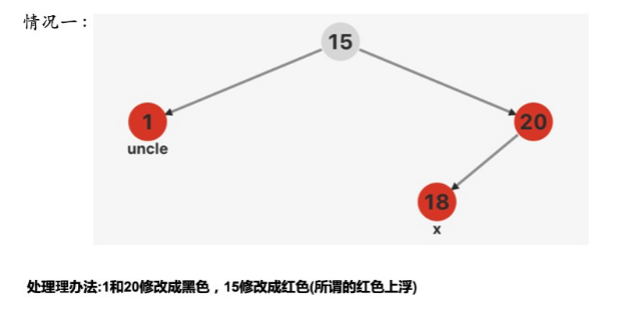
新插入节点是红色 (插入黑色一定造成失衡,插入红色不一定造成失衡(仅当父节点为红色))
插入操作干掉双红节点
调正操作 双红节点 -> 红黑黑 每条路径黑数量不变 (红色上浮)
1、插入调整站在<u>**祖父节点**</u>看 (往上回溯,向下看)
2、**每次调整后,黑色节点数量保持不变
当前节点下一红一黑的情况
(LR 小左旋) = LL 先大右旋,双红节点->红黑黑/黑红红
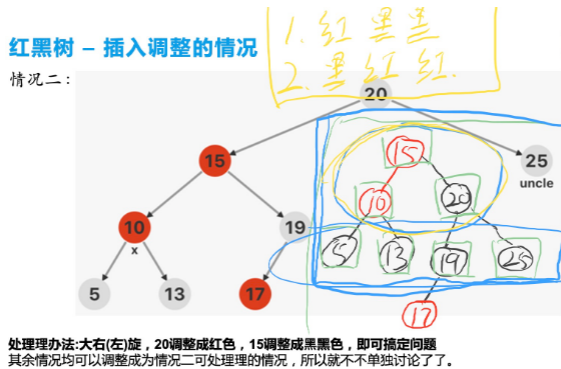
总结/代码
一、平衡条件
- 节点非黑既红
- 根节点是黑色
- 叶子(NIL)结点是黑色
- 红色节点下面接两个黑色节点
- 从根节点到叶子结点路径上,黑色节点数量相同
平衡条件的认识
第4条和第5条条件,注定了,红黑树中最⻓路径是最短路径的⻓度的 2 倍。
本质上,红黑树也是通过树高来控制平衡的。红黑树比 AVL 树树高控制条件要更松散,红黑树在发生节点插入和删除以后,发生调整的概率,比 AVL 树要更小。
二、学习诀窍
- 理解红黑树的插入调整,要站在 祖父节点 向下进行调整
- 理解红黑树的删除调整,要站在父节点向下进行调整
- 插入调整,主要就是为了解决双红情况
- 新插入的节点一定是红色,插入黑色节点一定会产生冲突,违反条件
- 插入红色节点,不一定产生冲突5. 把每一种情况,想象成一棵大的红黑树中的局部子树6. 局部调整的时候,为了不影响全局,调整前后的路径上黑色节点数量相同
三、插入策略
- 叔叔节点为红色的时候,修改三元组小帽子,改成红黑黑
- 叔叔节点为黑色的时候,参考 AVL 树的失衡情况,分成 L L , L R , R L , R R LL,LR,RL,RR LL,LR,RL,RR, 先参考 AVL 树的旋转调整策略,然后再修改三元组的颜色,有两种调整策略:红色上浮,红色下沉。3.
- 两大类情况,包含 8 种小情况
#include <stdio.h>
#include <string.h>
#include <stdlib.h>
#include <time.h>
typedef struct Node {
int key, color; // 0 red, 1 black
struct Node *lchild, *rchild;
} Node;
Node __NIL;
#define NIL (&__NIL)
__attribute__((constructor))
void inid_NIL() {
NIL->key = -1;
NIL->color = 1;
NIL->lchild = NIL->rchild = NIL;
return ;
}
Node *getNewNode(int key) { // 插入节点为红色
Node *p = (Node *)malloc(sizeof(Node));
p->key = key;
p->color = 0;
p->lchild = p->rchild = NIL;
return p;
}
void clear(Node *root) {
if(root == NIL) return ;
clear(root->lchild);
clear(root->rchild);
free(root);
return ;
}
bool has_red_child(Node *root) {
return (root->lchild->color == 0 || root->rchild->color == 0);
}
Node *left_rotate(Node *root) {
printf("left_rotate :%d \n", root->key);
Node *temp = root->rchild;
root->rchild = temp->lchild;
temp->lchild = root;
return temp;
}
Node *right_rotate(Node *root) {
printf("right_rotate :%d \n", root->key);
Node *temp = root->lchild;
root->lchild = temp->rchild;
temp->rchild = root;
return temp;
}
const char *insert_maintain_str[] = {"", "LL", "LR", "RL", "RR"};
Node *insert_maintain(Node *root) {
if(!has_red_child(root)) {//无红色孩子节点 终止
return root;
}
if(root->lchild->color == 0 && root->rchild->color == 0) {//两个红色孩子节点
if(!has_red_child(root->lchild) && !has_red_child(root->rchild)) {//非双红 终止
return root;
}
// 插入调整, 情况1, 红黑黑
printf("situation 1 : \n");
root->color = 0; //红色上浮
root->lchild->color = root->rchild->color = 1;
return root;
}
// root 下面一个红色,一个黑色,如果是,进去看看有没有冲突,否则返回
if(root->lchild->color == 0 && !has_red_child(root->lchild)) return root;//儿子节点是红色,孙子节点是黑色, 终止
if(root->rchild->color == 0 && !has_red_child(root->rchild)) return root;//儿子节点是红色,孙子节点是黑色, 终止
int flag = 0;
printf("situation 2 : \n");
if(root->lchild->color == 0) {
if(root->lchild->rchild->color == 0) {//左子树的右子树是红色
// LR 先小左旋
root->lchild = left_rotate(root->lchild);
flag = 2;
} else { flag = 1; }
root = right_rotate(root); //大右旋转
} else {
if(root->rchild->lchild->color == 0) {
// RL 先小右旋
root->rchild = right_rotate(root->rchild);
flag = 3;
} else { flag = 4; }
root = left_rotate(root); //大左旋
}
printf("maintain type : %s\n", insert_maintain_str[flag]);
//调整小三角,红黑黑
root->color = 0;
root->lchild->color = root->rchild->color = 1;
return root;
}
Node *__insert(Node *root, int key) {
if(root == NIL) return getNewNode(key);
if(root->key == key) return root;
if(root->key > key) {
root->lchild = __insert(root->lchild, key);
} else {
root->rchild = __insert(root->rchild, key);
}
return insert_maintain(root);//平衡调正操作
}
Node *insert(Node *root, int key) {//分两部走,根节点可能会变,强制改成黑色节点
root = __insert(root, key);
root->color = 1;
return root;
}
void output(Node *root) {
if(root == NIL) return ;
printf("(%d | %d, %d, %d) \n",
root->color, root->key, root->lchild->key, root->rchild->key);
output(root->lchild);
output(root->rchild);
return ;
}
int main() {
int n;
Node *root = NIL;
scanf("%d", &n);
for(int i = 0; i < n; i++) {
int val = rand() % 100;
printf("\n insert %d to RB_tree : \n", val);
root = insert(root, val);
output(root);
}
clear(root);
return 0;
}
删除的前提︰
1.删除红色节点(度为1不可能,路径长度不同)
a.度为0
b.度为2
2.删除黑色节点
a.度为2
b.度为1(度为1子节点一定是红色,红色变黑色,子节点是黑色不可能,路径长度不同)
c.度为0 (暂时引入双重黑节点,暂时平衡)
一、删除调整发生的前提
- 删除红色节点,不会对红黑树的平衡产生影响
- 度为1的黑色节点,唯一子孩子,一定是红色
- 删除度为1的黑色节点,不会产生删除旋转调整
- 删除度为0的黑色节点,会产生一个双重黑的 NIL 节点
- 删除调整,就是为了干掉双重
双重黑色节点(有向上传递的性质)
删除调整策略(父节点)
情况一:双重黑节点的兄弟节点是黑色,兄弟节点下面的两个子节点也是黑色
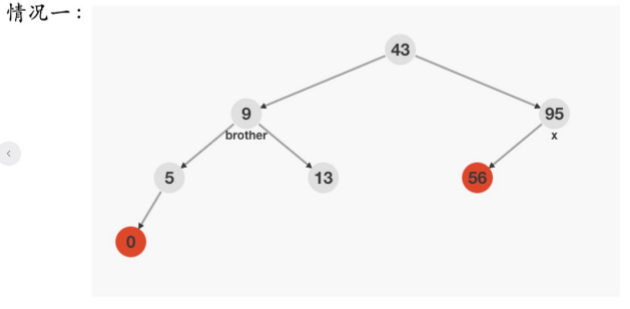
处理办法:父节点增加一重黑色,双重黑与兄弟节点,分别减少一重黑色(黑色向上传递)
情况二:双重黑节点的兄弟节点是黑色,兄弟节同一侧的子节点是红色
下图为RR型失衡 大左旋
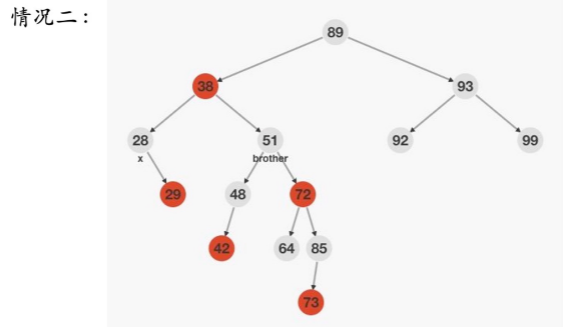
处理办法: father左(右)旋,由于无法确定48的颜色,所以38改成黑色,51改成38的颜色,×减少一重黑色,72改成黑色
让另一侧的黑色节点数量减一,同侧黑色节点数量加一,
1、38为黑色,左旋异侧减一,同侧加一
2、38为红色,左旋异侧不变,同侧加一,将38变为黑色,51变为红色,异侧减一
同侧加一,消去双重黑即可平衡,
异侧减一,将原来兄弟节同一侧的子节点变为黑色即可平衡。
51和38颜色对换保证异侧黑色节点数量一定减一,故将原来兄弟节同一侧的子节点变成红色即可保持平衡
情况三:
RR类型优先即大于RL类型
双重黑节点的兄弟节点是黑色,兄弟节同一侧的子节点是黑色,异侧节点为红色
下图为RL型失衡 小右旋 变为RR型失衡
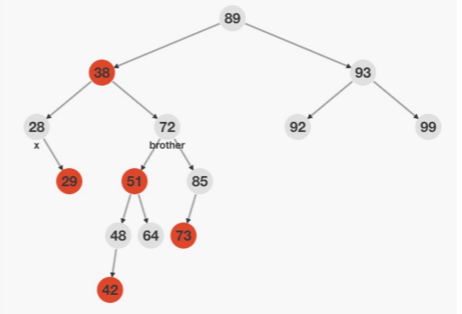
处理办法: brother右(左)旋,51变黑,72变红,转成处理情况二
情况四:
X的兄弟节点是红色怎么办?
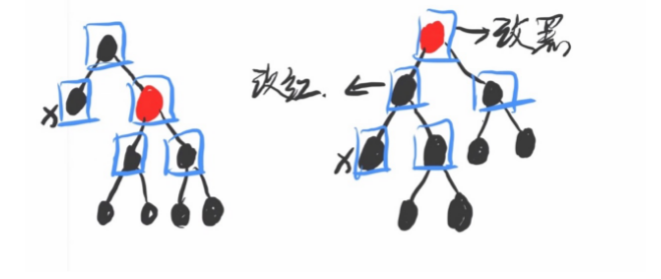
左旋,交换原父节点和原兄弟节点颜色
代码演示
- 进行 LR/RL 类型判断的时候,不能判断 LL 子树是否为黑色,LL 子树有可能是 NIL 节点,在某些特殊情况下,读到的颜色可能是双重黑,取而代之的判断方法就是【LL 子树不是红色】。
#include <stdio.h>
#include <string.h>
#include <stdlib.h>
#include <time.h>
typedef struct Node {
int key, color; // 0 red, 1 black, 2 double black
struct Node *lchild, *rchild;
} Node;
Node __NIL;
#define NIL (&__NIL)
__attribute__((constructor))
void inid_NIL() {
NIL->key = -1;
NIL->color = 1;
NIL->lchild = NIL->rchild = NIL;
return ;
}
Node *getNewNode(int key) {
Node *p = (Node *)malloc(sizeof(Node));
p->key = key;
p->color = 0;
p->lchild = p->rchild = NIL;
return p;
}
void clear(Node *root) {
if(root == NIL) return ;
clear(root->lchild);
clear(root->rchild);
free(root);
return ;
}
bool has_red_child(Node *root) {
return (root->lchild->color == 0 || root->rchild->color == 0);
}
Node *left_rotate(Node *root) {
printf("left_rotate :%d \n", root->key);
Node *temp = root->rchild;
root->rchild = temp->lchild;
temp->lchild = root;
return temp;
}
Node *right_rotate(Node *root) {
printf("right_rotate :%d \n", root->key);
Node *temp = root->lchild;
root->lchild = temp->rchild;
temp->rchild = root;
return temp;
}
const char *insert_maintain_str[] = {"", "LL", "LR", "RL", "RR"};
Node *insert_maintain(Node *root) {
if(!has_red_child(root)) {
return root;
}
if(root->lchild->color == 0 && root->rchild->color == 0) {
if(!has_red_child(root->lchild) && !has_red_child(root->rchild)) {
return root;
}
// 插入调整, 情况1, 红黑黑
printf("situation 1 : \n");
root->color = 0;
root->lchild->color = root->rchild->color = 1;
return root;
}
if(root->lchild->color == 0 && !has_red_child(root->lchild)) return root;
if(root->rchild->color == 0 && !has_red_child(root->rchild)) return root;
int flag = 0;
printf("situation 2 : \n");
if(root->lchild->color == 0) {
if(root->lchild->rchild->color == 0) {
// LR 先左旋
root->lchild = left_rotate(root->lchild);
flag = 2;
} else { flag = 1; }
root = right_rotate(root);
} else {
if(root->rchild->lchild->color == 0) {
// RL 先右旋
root->rchild = right_rotate(root->rchild);
flag = 3;
} else { flag = 4; }
root = left_rotate(root);
}
printf("maintain type : %s\n", insert_maintain_str[flag]);
root->color = 0;
root->lchild->color = root->rchild->color = 1;
return root;
}
Node *__insert(Node *root, int key) {
if(root == NIL) return getNewNode(key);
if(root->key == key) return root;
if(root->key > key) {
root->lchild = __insert(root->lchild, key);
} else {
root->rchild = __insert(root->rchild, key);
}
return insert_maintain(root);
}
Node *insert(Node *root, int key) {
root = __insert(root, key);
root->color = 1;
return root;
}
Node *get_pre(Node *root) {
Node *temp = root->lchild;
while(temp->rchild != NIL) temp = temp->rchild;
return temp;
}
Node *erase_maintain(Node *root) {
// 站在父节点, 看看两个孩子没有有双重黑色
if(root->lchild->color != 2 && root->rchild->color != 2) {
return root;
}
// 先处理一个双黑一个红色
//情况四、右红则左旋,交换原父节点和原兄弟节点颜色
if(has_red_child(root)) {
int flag = 0; // flag 是记一下, 红色节点在哪里
// 先让原来的老根, 变成红色
root->color = 0;
if(root->lchild->color == 0) {
root = right_rotate(root); //右旋
flag = 1;
} else {
root = left_rotate(root); //左旋
flag = 2;
}
root->color = 1;
if(flag == 1) root->rchild = erase_maintain(root->rchild);
else root->lchild = erase_maintain(root->lchild);
return root;
}
// 情况1, 兄弟节点的两个孩子也是双黑 双黑向上传递
if((root->lchild->color == 2 && !has_red_child(root->rchild))
|| (root->rchild->color == 2 && !has_red_child(root->lchild))) {
root->lchild->color -= 1;
root->rchild->color -= 1;
root->color += 1;
return root;
}
// 情况2和情况3的处理
// 当左节点是双黑的时候 向黑色节点旋转
if(root->lchild->color == 2) {
// 减掉双黑的一重黑色
root->lchild->color = 1;
// RL
if(root->rchild->rchild->color != 0) {
// RL 需要先进行一次小右旋, 原根变红, 新根边黑
root->rchild->color = 0;
root->rchild = right_rotate(root->rchild);
root->rchild->color = 1;
}
// RR
root = left_rotate(root);
root->color = root->lchild->color;
} else {
root->rchild->color = 1;
// LR
if(root->lchild->lchild->color != 0) {
// LR 需要先进行一次小左旋, 原根变红, 新根边黑
root->lchild->color = 0;
root->lchild = left_rotate(root->lchild);
root->lchild->color = 1;
}
// LL
root = right_rotate(root);
root->color = root->rchild->color;
}
root->lchild->color = root->rchild->color = 1;
return root;
}
Node *__erase(Node *root, int key) {
if(root == NIL) return NIL;
if(root->key > key) {
root->lchild = __erase(root->lchild, key);
} else if(root->key < key) {
root->rchild = __erase(root->rchild, key);
} else {
// 处理度为0或者度为1
if(root->lchild == NIL || root->rchild == NIL) {
Node *temp = root->lchild != NIL ? root->lchild : root->rchild;
temp->color += root->color; //
free(root);
return temp;
} else {
//处理度为二的节点
Node *temp = get_pre(root);
root->key = temp->key;//找前驱节点覆给root,删除前驱节点,转换为度为1或2的情况
root->lchild = __erase(root->lchild, temp->key);
}
}
return erase_maintain(root);
}
Node *erase(Node *root, int key) {
root = __erase(root, key);
root->color = 1;
return root;
}
void output(Node *root) {
if(root == NIL) return ;
printf("(%d | %d, %d, %d) \n",
root->color, root->key, root->lchild->key, root->rchild->key);
output(root->lchild);
output(root->rchild);
return ;
}
int main() {
int n;
Node *root = NIL;
int op, val;
while(~scanf("%d%d", &op, &val)) {
switch(op) {
case 1 : root = insert(root, val); break;
case 2 : root = erase(root, val); break;
}
output(root);
printf("---------------------\n");
}
clear(root);
return 0;
}
哈夫曼编码
定长与变长编码
1.Ascii编码和特定场景下的自定义编码,都属于定长编码
2.对于每一个字符,编码长度相同,这就是定长编码
3.UTF-8编码,是变长编码,UTF-16,是定长编码
4.对于每一个字符,编码长度不相同,这就是变长编码
前缀编码可以保证对压缩文件进行解码时不产生二义性,确保正确解码。
哈夫曼编码符合“前缀编码”的要求,即较短的编码不能是任何较长的编码的前缀。
哈夫曼编码生成过程:
1.首先,统计得到每一种字符的概率
2.将n 个字符,建立成一棵哈弗曼树
概率最小的放下面,每一个节点放在叶子节点
3.每一个字符,都落在叶子结点上
4.按照左0,右1的形式,将编码读取出来
结论:哈弗曼编码,是最优的变长编码
-
首先表示平均编码⻓度,求解公式最优解
-
最终,和熵与交叉熵之间的关系
2^(H-L) 代表编码长度为L的使用了多少个节点

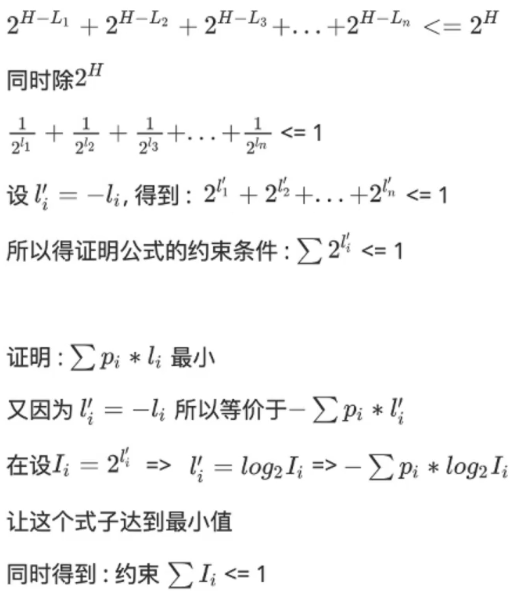
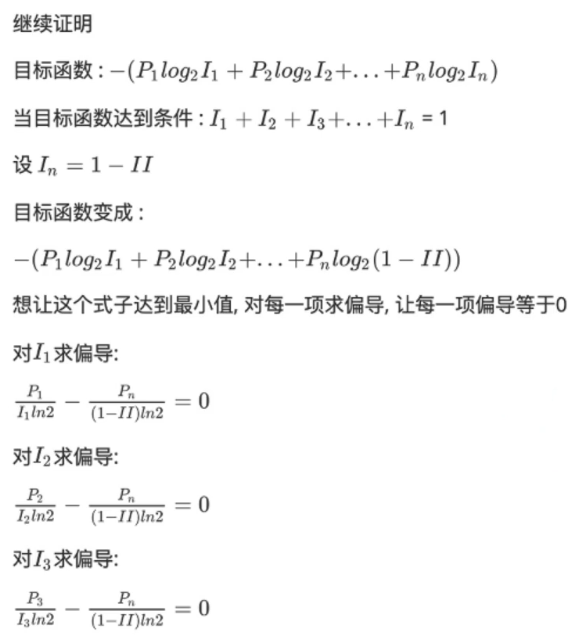
代码演示
#include <stdio.h>
#include <stdlib.h>
#include <string.h>
#include <iostream>
#include <algorithm>
#include <queue>
using namespace std;
typedef struct Node {
char ch;
double freq;
struct Node *lchild, *rchild;
} Node;
struct cmp {
bool operator() (const Node *a, const Node *b) {
return a->freq > b->freq;
}
};
priority_queue<Node*, vector<Node*>, cmp> q; //存Node的优先队列
Node *getNewNode(char ch, double freq, Node *lchild, Node *rchild) {
Node *p = (Node*)malloc(sizeof(Node));
p->ch = ch;
p->freq = freq;
p->lchild = lchild;
p->rchild = rchild;
return p;
}
void clear(Node *root) {
if(root == NULL) return ;
clear(root->lchild);
clear(root->rchild);
free(root);
return ;
}
Node *buildHalfmman() {
while(!q.empty()) {
Node *a = q.top();
q.pop();
Node *b = q.top();
q.pop();
q.push(getNewNode(0, a->freq + b->freq, a, b));
}
return q.top();
}
void getHalfmmanCode(Node *root, int k, char *buff, char *code[]) { //k是第几个,buff是单个编码, code[]是连续的编码
if(root == NULL) return ;
buff[k] = 0;
if(root->ch) {
code[root->ch] = strdup(buff);
return ;
}
buff[k] = '0';
getHalfmmanCode(root->lchild, k + 1, buff, code); //递归遍历
buff[k] = '1';
getHalfmmanCode(root->rchild, k + 1, buff, code);
return ;
}
int main() {
int n;
scanf("%d", &n);
for(int i = 0; i < n; i++) {
char ch[10];
double freq;
scanf("%s%lf", ch, &freq);
q.push(getNewNode(ch[0], freq, NULL, NULL));
}
Node *root = buildHalfmman();
char *code[256] = {0}, buff[100];
getHalfmmanCode(root, 0, buff, code);
for(int i = 1; i < 256; i++) {
if(code[i] == NULL) continue;
printf("%c : %s\n", i, code[i]);
}
return 0;
}
刷题
LRU 缓存机制
struct DlinkNode { //双向链表
int key, value;
DlinkNode *next, *pre;
DlinkNode() : key(0), value(0), next(nullptr), pre(nullptr) {}
DlinkNode(int _key, int _value) : key(_key), value(_value), next(nullptr), pre(nullptr) {}
};
class LRUCache {
public:
unordered_map<int, DlinkNode*> hash;
DlinkNode *head, *tail;
int size, m_capacity;// size当前大小,m_capacity最大容量
LRUCache(int capacity) {
m_capacity = capacity;
head = new DlinkNode();
tail = new DlinkNode();
head->next = tail;
tail->pre = head;
size = 0;
}
int get(int key) {
if(!hash.count(key)) {
return -1;
}
move_head(key);//放在头部
return hash[key]->value;
}
void move_head(int key) {
DlinkNode *node = hash[key];
node->pre->next = node->next;
node->next->pre = node->pre;
head->next->pre = node;
node->next = head->next;
head->next = node;
node->pre = head;
return ;
}
void add_node(DlinkNode *node) {
head->next->pre = node;
node->next = head->next;
node->pre = head;
head->next = node;
return ;
}
void delete_node() {
DlinkNode *node = tail->pre;
int key = node->key;
tail->pre = node->pre;
node->pre->next = tail;
hash.erase(key);
delete node;
return ;
}
void put(int key, int value) {
if(!hash.count(key)) {
if(size >= m_capacity) {
delete_node();
size--;
}
DlinkNode *node = new DlinkNode(key, value);
add_node(node);
size++;
hash[key] = node;
} else {
DlinkNode *node = hash[key];
node->value = value;
move_head(key);
}
return ;
}
};
/**
* Your LRUCache object will be instantiated and called as such:
* LRUCache* obj = new LRUCache(capacity);
* int param_1 = obj->get(key);
* obj->put(key,value);
*/
古老打字机
蒜头君有一台古老的打印机,在打印机上有 2828个按键,其中:
a - z:输入一个小写英文字母;
DEL:删除当前输入的单词的最后一个字母;
PRINT:打印当前输入的单词。
蒜头君想使用这台打印机打印出 nn 个英文单词,打印单词的顺序无所谓。求蒜头君最少需要按多少次按钮。
输入格式
输入包含多组测试数据,对于每组测试数据:
第一行输入一个整数 nn(1 \leq n \leq 100001≤n≤10000),表示一共需要打印的单词数。
接下来输入 nn 行,每行输入一个单词,每个单词的长度不超过 5050,并且只包含小写英文字母。
输出格式
对于每组测试数据,输出一个整数,表示打印出这些单词,蒜头君最少需要按的按钮次数。
样例输入复制
3
apple
add
oppo
样例输出复制
20
代码
#include <stdio.h>
#include <string.h>
#include <stdlib.h>
typedef struct Node {
struct Node* next[26];
} Node;
int count = 0;
Node *getNewNode() {
Node *p = (Node*)malloc(sizeof(Node));
memset(p->next, 0, sizeof(p->next));
return p;
}
void insert(Node *root, char *str) {
Node *p = root;
for(int i = 0; str[i]; i++) {
if(p->next[str[i] - 'a'] == NULL) {
p->next[str[i] - 'a'] = getNewNode();
count++;
}
p = p->next[str[i] - 'a'];
}
return ;
}
int main() {
int n;
while(scanf("%d", &n) != EOF) {
count = 0;
Node *root = getNewNode();
char str[512];
int max_len = 0, len;
for(int i = 0; i < n; i++) {
scanf("%s", str);
len = strlen(str);
max_len = max_len < len ? len : max_len;
insert(root, str);
}
int ans = count * 2 + n - max_len;
printf("%d\n", ans);
}
return 0;
}
字符串旋转矩阵
已知一个字符串 ss,例如hello,在其末尾添加一个结束符$, 然后对其进行 nn 次旋转,其中 nn 为字符串 ss 的长度,于是一共得到了 n+1n+1个字符串,例如对于字符串hello得到:
1
hello$
2
ello$h
3
llo$he
4
lo$hel
5
o$hell
6
$hello
然后对这 n+1n+1 个字符串按照字典序排序,得到一个字符矩阵:
1
$hello
2
ello$h
3
hello$
4
llo$he
5
lo$hel
6
o$hell
对于该字符矩阵的最后一列,由上到下得到一个字符串 TT =oh$ell。
现在已知字符串 TT,有 mm 次询问,求字符串 strstr 是否是原字符串 ss 的子串。
输入格式
输入包含多组测试数据,对于每组测试数据:
第一行包含一个字符串 T(1 \leq |T| \leq 110000)T(1≤∣T∣≤110000),字符串 TT 中只包含小写英文字母和一个$。
第二行包含一个整数 m (m \leq 110000)m(m≤110000)。
接下来 mm 行每行包含一个字符串 strstr(|str| \times m \leq 2 \times 10^{6}∣str∣×m≤2×106),字符串 strstr 中只包含小写英文字母。
输出格式
对于每组测试数据的每次询问,输出一个结果,如果该字符串是原字符串 ss 的子串,输出YES,否则输出NO。
注意: 本题难度较大,为选做题,提交任意一份代码就可以跳过这一节。
样例输入复制
oh$ell
3
hel
ho
ele
样例输出复制
YES
NO
NO
代码
#include <iostream>
#include <queue>
#include <algorithm>
#include <cstdio>
#include <cstring>
#include <cstdlib>
using namespace std;
const int maxn = 210000;
char s[maxn], t[maxn];
int ind[maxn];
bool cmp(int i, int j) {
if (t[i] != t[j]) return t[i] < t[j];
return i < j;
}
void conver(char *t, char *s) {
int n = 0;
for (n = 0; t[n]; n++) {
ind[n] = n;
}
sort(ind, ind + n, cmp);
/*for (int i = 0; i < n; i++) {//排完序后下标的值,第一列
printf("%d", ind[i]);
}*/
int p = ind[0];
for (int i = 0; i < n; i++) {
s[i] = t[p];
p = ind[p];
}
s[n] = '\0';
return ;
}
const int maxm = 2e6 + 10;
int *ans[maxn];
struct Node {
int flag, *ans;
int next[26], fail;
} tree[maxm];
int root = 1, cnt = 2;
int getNewNode() {return cnt++;}
int *insert(char *s) {
int p = root;
for (int i = 0; s[i]; i++) {
int ind = s[i] - 'a';
if (tree[p].next[ind] == 0) tree[p].next[ind] = getNewNode();
p = tree[p].next[ind];
}
tree[p].flag = 1;
if (tree[p].ans == NULL) {
tree[p].ans = new int(0);
}
return tree[p].ans;
}
void build() {
queue<int> que;
tree[root].fail = 0;
for (int i = 0; i < 26; i++) {
if (tree[root].next[i] == 0) {
tree[root].next[i] = root;
continue;
}
tree[tree[root].next[i]].fail = root;
que.push(tree[root].next[i]);
}
while(!que.empty()) {
int p = que.front();
que.pop();
for (int i = 0; i < 26; i++) {
int c = tree[p].next[i], k = tree[p].fail;
if (c == 0) {
tree[p].next[i] = tree[k].next[i];
continue;
}
tree[c].fail = tree[k].next[i];
que.push(c);
}
}
return ;
}
void match(char *s) {
int ind = s[0] - 'a';
int p = tree[root].next[ind], q, k;
for (int i = 0; s[i]; i++, p = tree[p].next[s[i] - 'a']) {
q = p;
while (q) {
if (tree[q].flag) {
*tree[q].ans += 1;
}
k = q;
q = tree[q].fail;
tree[k].fail = 0;
}
}
}
int solve(char *t) {
memset(ans, 0, sizeof(ans));
memset(tree, 0, sizeof(tree));
cnt = 2;
conver(t, s);
int n;
scanf("%d", &n);
for (int i = 0; i < n; i++) {
scanf("%s", t);
ans[i] = insert(t); //tree[p].ans 同名
}
build();
match(s + 1);//把$丢掉
for (int i = 0; i < n; i++) {
if (ans[i][0]) {
printf("YES\n");
} else {
printf("NO\n");
}
}
return 0;
}
int main() {
while (scanf("%s", &t) != EOF) {
solve(t);
}
return 0;
}
二叉搜索树的最近公共祖先
/**
* Definition for a binary tree node.
* struct TreeNode {
* int val;
* TreeNode *left;
* TreeNode *right;
* TreeNode(int x) : val(x), left(NULL), right(NULL) {}
* };
*/
class Solution {
public:
TreeNode* lowestCommonAncestor(TreeNode* root, TreeNode* p, TreeNode* q) {
if (p->val < root->val && q->val < root->val) {
return lowestCommonAncestor(root->left, p, q);
}
if (p->val > root->val && q->val > root->val) {
return lowestCommonAncestor(root->right, p, q);
}
return root;
}
};
路径总和
/**
* Definition for a binary tree node.
* struct TreeNode {
* int val;
* TreeNode *left;
* TreeNode *right;
* TreeNode() : val(0), left(nullptr), right(nullptr) {}
* TreeNode(int x) : val(x), left(nullptr), right(nullptr) {}
* TreeNode(int x, TreeNode *left, TreeNode *right) : val(x), left(left), right(right) {}
* };
*/
class Solution {
public:
bool hasPathSum(TreeNode* root, int targetsum){
if (root == nullptr) return false;
if (root->left == nullptr && root->right == nullptr){// 叶子结点
return targetsum == root->val;
}
targetsum -= root->val;
return hasPathSum(root->left, targetsum) || hasPathSum(root->right, targetsum);
}
};
二叉树中的最大路径和(巧妙)
/**
* Definition for a binary tree node.
* struct TreeNode {
* int val;
* TreeNode *left;
* TreeNode *right;
* TreeNode() : val(0), left(nullptr), right(nullptr) {}
* TreeNode(int x) : val(x), left(nullptr), right(nullptr) {}
* TreeNode(int x, TreeNode *left, TreeNode *right) : val(x), left(left), right(right) {}
* };
*/
class Solution {
public:
int ans = -0x3f3f3f3f;
int dfs(TreeNode *root) {
if (root == nullptr) return 0;
int left = max(0, dfs(root->left));
int right = max(0, dfs(root->right));
ans = max(ans, left + right + root->val);
return root->val + max(left, right);
}
int maxPathSum(TreeNode* root) {
dfs(root);
return ans;
}
};
不同的二叉搜索树
class Solution {
public:
int mp[200][200] = {0};
int dfs(int l, int r) { // l号结点 到 n号结点
if (l > r) return 1; //边界条件
if (mp[l][r] != 0) return mp[l][r];
int res;
for (int i = l;i <= r; i++) {
res += (dfs(l, i - 1) * dfs(i + 1, r));
}
mp[l][r] = res;
return res;
}
int numTrees(int n) {
if (n == 1) return 1;
return dfs(1, n);
}
};
不同的二叉搜索树 II(排列组合)
/**
* Definition for a binary tree node.
* struct TreeNode {
* int val;
* TreeNode *left;
* TreeNode *right;
* TreeNode() : val(0), left(nullptr), right(nullptr) {}
* TreeNode(int x) : val(x), left(nullptr), right(nullptr) {}
* TreeNode(int x, TreeNode *left, TreeNode *right) : val(x), left(left), right(right) {}
* };
*/
class Solution {
public:
vector<TreeNode*> dfs(int l, int r) {
vector<TreeNode*> ans;
if (l > r) { // 边界条件
ans.push_back(nullptr);
return ans;
}
for (int i = l; i <= r; i++) {
vector<TreeNode*> left_arr = dfs(l, i - 1);
vector<TreeNode*> right_arr = dfs (i + 1, r);
for (TreeNode *left : left_arr) { // 遍历整个树,排列组合
for (TreeNode *right : right_arr) {
TreeNode *t = new TreeNode(i, left, right);
ans.push_back(t);
}
}
}
return ans;
}
vector<TreeNode*> generateTrees(int n) {
if (n == 0) return vector<TreeNode*>{};
return dfs(1, n);
}
};
字串匹配
已知一个字符串 aa 和一个字符串 bb,求字符串 aa 中包含子串 bb 的数量。为了减小输入量,输入中对字符串 aa 进行了压缩,对于字符串 aa 中存在多个连续重复子串,使用方括号括起来,之后一个整数表示该子串连续出现的次数,比如字符串wabababyui可以表示为w[ab]3yui。
输入格式
第一行输入一个字符串 aa,该字符串仅包含小写英文字母、数字和方括号"[]",长度不超过 10001000,并且不存在括号嵌套的情况。方括号后面的数字不超过 10001000。
第二行包含一个字符串 bb,该字符串仅包含小写英文字母,长度不超过 100100,对于大多数测试数据,字符串 bb 的长度都比较短。
输出格式
对于每组测试数据,输出一个整数,表示字符串 aa 中包含子串 bb 的数量。
样例输入1复制
c[ab]2[da]2da
bd
样例输出1复制
1
样例输入2复制
b[an]3
na
样例输出2复制
2
代码
#include <iostream>
#include <cstring>
#include <algorithm>
using namespace std;
const int maxn = 1e6 + 10;
char a[maxn], b[maxn];
char t[maxn];
char tmp[maxn];
void get_string(char *s) {
int flag = 0, ind = 0, ind_t = 0;
for (int i = 0; s[i]; i++) {
if(s[i] == '[') {
flag = 1;
ind = 0;
} else if(s[i] == ']') {
flag = 0;
tmp[ind] = '\0';
int x = 0;
i++;
while (s[i] <= '9' && s[i] >= '0') {
x = x * 10 + (s[i] - '0');
i++;
}
i--;
while (x--) {
strcat(t, tmp);
ind_t += ind;
}
} else if (flag == 1) {
tmp[ind++] = s[i];
} else {
t[ind_t++] = s[i];
}
}
t[ind_t++] = '\0';
//printf("%s", t);
return ;
}
void sunday(char *s, char *t) {
int str_p[3000];
int len_t = strlen(t);
int len_s = strlen(s);
int ans = 0;
for (int i = 0; i < 300; i++) {
str_p[i] = len_t + 1;
}
for (int i = 0; i <len_t; i++) {
str_p[t[i]] = len_t - i;
}
int i = 0, j = 0;
while (i + len_t <= len_s) {
if (s[i + j] != t[j]) {
i += str_p[s[i + len_t]];
j = 0;
} else {
j++;
}
if (t[j] == '\0') {
ans++;
}
}
printf("%d", ans);
return ;
}
int main() {
scanf("%s%s", a, b);
get_string(a);
sunday(t, b);
return 0;
}
strcat 将两个char类型连接
extern char *strcat(char *dest, const char *src);
strdup()函数是c语言中常用的一种字符串拷贝库函数,strdup()在内部调用了malloc()为变量分配内存,不需要使用返回的字符串时,需要用free()释放相应的内存空间,否则会造成内存泄漏。






















 1331
1331











 被折叠的 条评论
为什么被折叠?
被折叠的 条评论
为什么被折叠?








